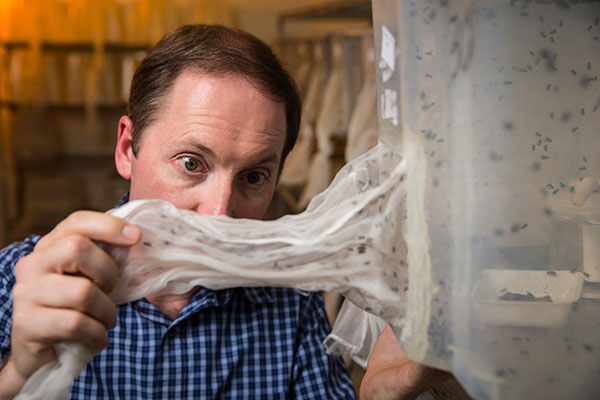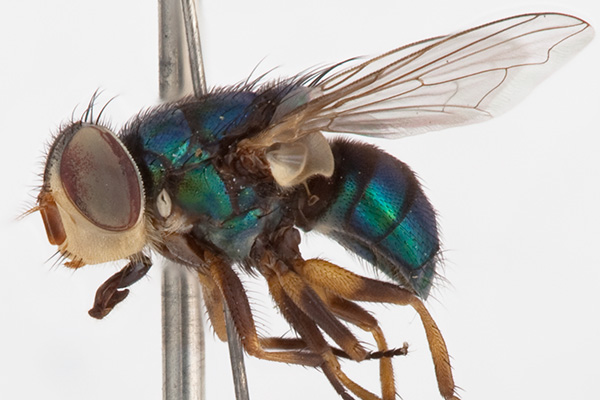February 12, 2015
Lifting the covers on the secret sex lives of flies
Researchers become a fly on the wall to observe the courtship rituals of the blowfly.

Good looks, nice clothes and fancy moves are not traits commonly associated with blowflies, yet UOW researchers have found their courtship behaviours are far more complicated than previously thought.
Researchers from UOW’s School of Biological Sciences, Associate Professor James Wallman (pictured above) and Dr Phil Byrne, spied on the courtship rituals and sex lives of the small hairy maggot blowfly to better understand how they choose a mate and continue the breeding cycle.
Australian fly enthusiasts have known about the unique mating rituals of this species of blowfly for years, but they remained completely unstudied and undocumented in the lab.
Small hairy maggot blowflies breed in carrion – dead animals – and play an important role as nutrient recyclers and can even be used to aid forensic investigations.
Previous studies in insects and other animals have looked only at a single trait, such as a type of behaviour during courtship, and assessment was restricted to a single sex. Yet, questions remained about whether the females assessed several traits as they sized up potential partners.
“Mate choice is a powerful evolutionary force because it has a direct influence on an individual’s reproductive success and the likelihood of passing genes on to the next generation,” Dr Byrne said.
“By influencing the reproductive success of individuals, and the quality of their offspring, mate choice can affect the viability of an entire population, and in turn, the probability that a species persists or perishes.”
The group’s findings, published recently in the journal Animal Behaviour, found collective traits were more important that a single, dominant trait in mate choice in both the males and females.
Their experiments involved placing randomly selected male and female blowfly pairs in Petri dishes with a dinner of kangaroo meat and recording with multiple cameras the ensuing courtship and possible sex.

A female small hairy maggot blowfly (chrysomya varipes).
The researchers ran eight simultaneous experiments where the blind date couples were separated by cardboard barriers to ensure each couple could not be influenced or interrupted by their neighbours.
They specifically attempted to identify if the likelihood of male flies mating was affected by their physical appearance or the effort put into their courtship rituals.
Results of the experiments revealed that males who invested significant energy in courtship, as well as sporting an attractive set of forelegs, had the increased chance of mating success.
A male with a lighter body weight was also able to spend more time chasing, tapping, waving, arching his body to show off his legs and vibrating his wings in front of the female.
Females with longer leg hairs, thought to be a sign of her reproductive quality, had the most success attracting a mate, with males investing significantly more time in wooing the potential mate.
Professor Wallman, who has studied insects for more than 25 years, said flies needed to mate in order to reproduce and produce their maggot offspring, so studying their mating behaviour is fundamental to understanding their biology.
“Most people think of flies as just a nuisance, but, in many ways, they are just like us. The boy still has to show off to win the girl’s affection, so a lot of what we observed going on – even if it was in a Petri dish rather than the bedroom – gave us no real surprises at all!”
Professor Wallman said the initial experiments opened up other areas to explore, such as the role of sound and smell in flies’ sex lives.
“The many parallels with human behaviours are obvious, although thankfully we mostly refrain from courting each other in the vicinity of a rotting corpse.”